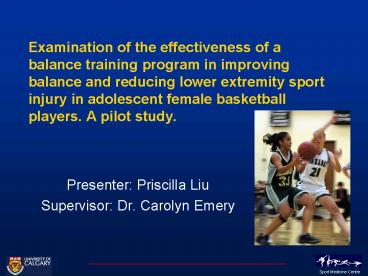Examination of the effectiveness of a balance training program in improving balance and reducing low - PowerPoint PPT Presentation
1 / 34
Title:
Examination of the effectiveness of a balance training program in improving balance and reducing low
Description:
Sport Medicine Centre. Prevention of Basketball Injuries ... Sport Medicine Centre. Training Group. 6-week balance training program using a wobble board ... – PowerPoint PPT presentation
Number of Views:164
Avg rating:3.0/5.0
Title: Examination of the effectiveness of a balance training program in improving balance and reducing low
1
Examination of the effectiveness of a balance
training program in improving balance and
reducing lower extremity sport injury in
adolescent female basketball players. A pilot
study.
- Presenter Priscilla Liu
- Supervisor Dr. Carolyn Emery
2
Agenda
- Background
- Methods
- Results
- Discussion
- Conclusion
- Acknowledgements
3
Background
- Epidemiology of basketball injuries in
adolescents - Sport participation
- Injury Rate
- Injury location and severity
- Risk factors
- - intrinsic and extrinsic
4
Prevention of Basketball Injuries
- Prevention of lower extremity injuries
- Taping, bracing, shoes, multi-dimensional
training program - Proprioceptive balance training program in
soccer, European handball - Emery et al proprioceptive balance training in
healthy adolescents
5
Study Objectives
- Effectiveness of a 6 weeks proprioceptive wobble
training program in - 1) improving dynamic balance
- 2) reducing lower extremity injuries
6
Study Design
- Non-randomized prospective intervention study
- U of C summer Dinos Athletics female basketball
camp in July
7
Subjects
- Adolescents females between age 11-17
- 44 girls from first week of camp
- 45 girls from second week of camp
8
Methods
- Baseline Measurements
- Baseline questionnaire age, past history on
injury and sport participation - Tanner staging skeletal assessment
- Height, weight, leg dominance, vertical jump,
ankle dorsiflexion, popliteal angle, VO2 max - Eyes closed unipedal dynamic (ECD) balance
9
Data Collection
- 6 week follow-up
- ECD balance
- 16 week follow-up
- 1) Sport participation journals
- 2) Injury report
10
11
(No Transcript)
12
Strength and Endurance
Vertical Jump Shuttle Run (functional
strength) (predicted VO2 max)
13
Unipedal Dynamic Balance Test
14
Training Group
- 6-week balance training program using a wobble
board - Performed wobble board exercises during warm-up
in the week of camp - Followed home-based wobble board training program
post camp - 5 times a week for 20 minutes with progression
15
(No Transcript)
16
Results
- 45/89 (50.6 95CI 39.8-61.3) completed all
follow up components - 64/89 (71.9 95CI 61.4-80.9) completed all
components except 6 week follow up assessment
17
Results
- No significant differences between the groups at
baseline except tanner staging - Training group was younger in physiological
maturity - No significant differences between dropouts and
those completing study
18
Wobble Board Compliance
19
Difference between baseline and six-weeks
follow-up for ECD balance (seconds) on
non-dominant leg
20
Difference between baseline and six-weeks
follow-up for ECD balance (seconds) on dominant
leg
21
Sport injuries requiring medical attention or
time loss from sport
22
Injury Region and Time Loss
23
Mean hours and injuries for basketball and all
sports played
24
Sport participation hours and number of injuries
25
Relative risk of injury with injury in the past
year
RR 4.2 (95 CI 1.01, 24.79)
26
Discussion
- No significant difference in ECD balance
- No significant difference in injury incidence
27
Discussion
- Limitations
- 1)Summer season
- 2) Only 50.6 of participants returned for 6 week
follow up
28
Discussion
- 3) Dropouts for control and training group were
34 and 22 - 4) 51.2(95CI 35.8-66.3) reported less than 5
wobble board sessions post camp - 5) Incomplete data on sport participation
journals and injury report forms
29
Discussion
- Other risk factors
- Past injury RR 4.2 (95CI 1.01, 24.79)
- Reasons could be persistent symptoms, underlying
physiological deficiencies from previous injury,
inadequate rehabilitation
30
Discussion
- Lessons Learned
- Challenges in adapting injury prevention model
that can be incorporated into daily lives of
adolescents - Motivational strategies to establish adherence
31
Discussion
- Lessons Learned
- Understanding of behaviour, attitude, social
influence and self efficacy of the adolescent age
group - Need for group level involvement in developing
prevention plan
32
Discussion
- Future Studies
- Sport specific injury prevention programs for
adolescents - Prevention program adherence
- Prevention program evaluation effectiveness,
acceptability and applicability
33
Acknowledgements
- Dr. Carolyn Emery and research staff
- Dr. Aaron Tubman and Markin-Flanagan Studentship
Undergraduate Research Project - Dinos basketball coaches, participants and
parents
34
Thank you































